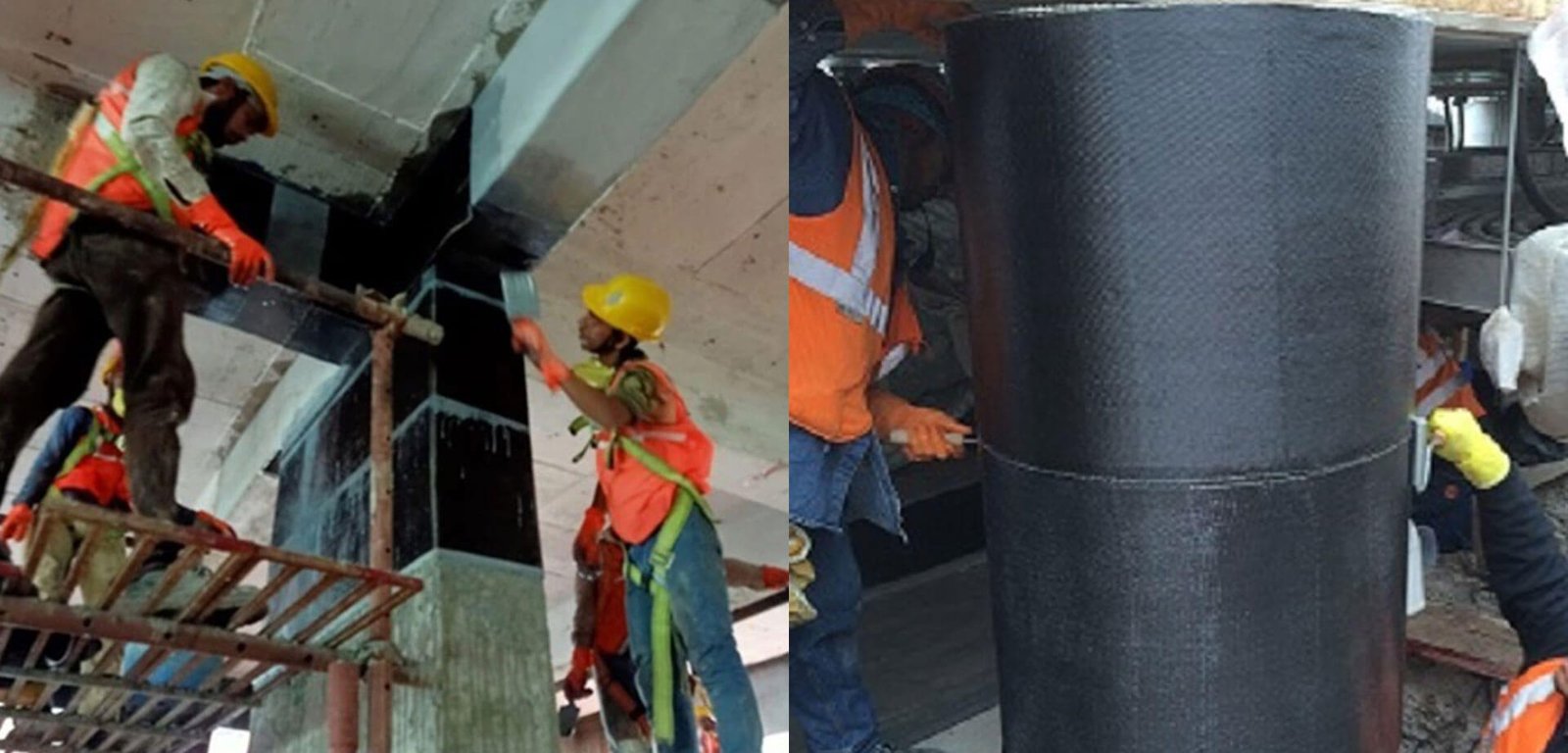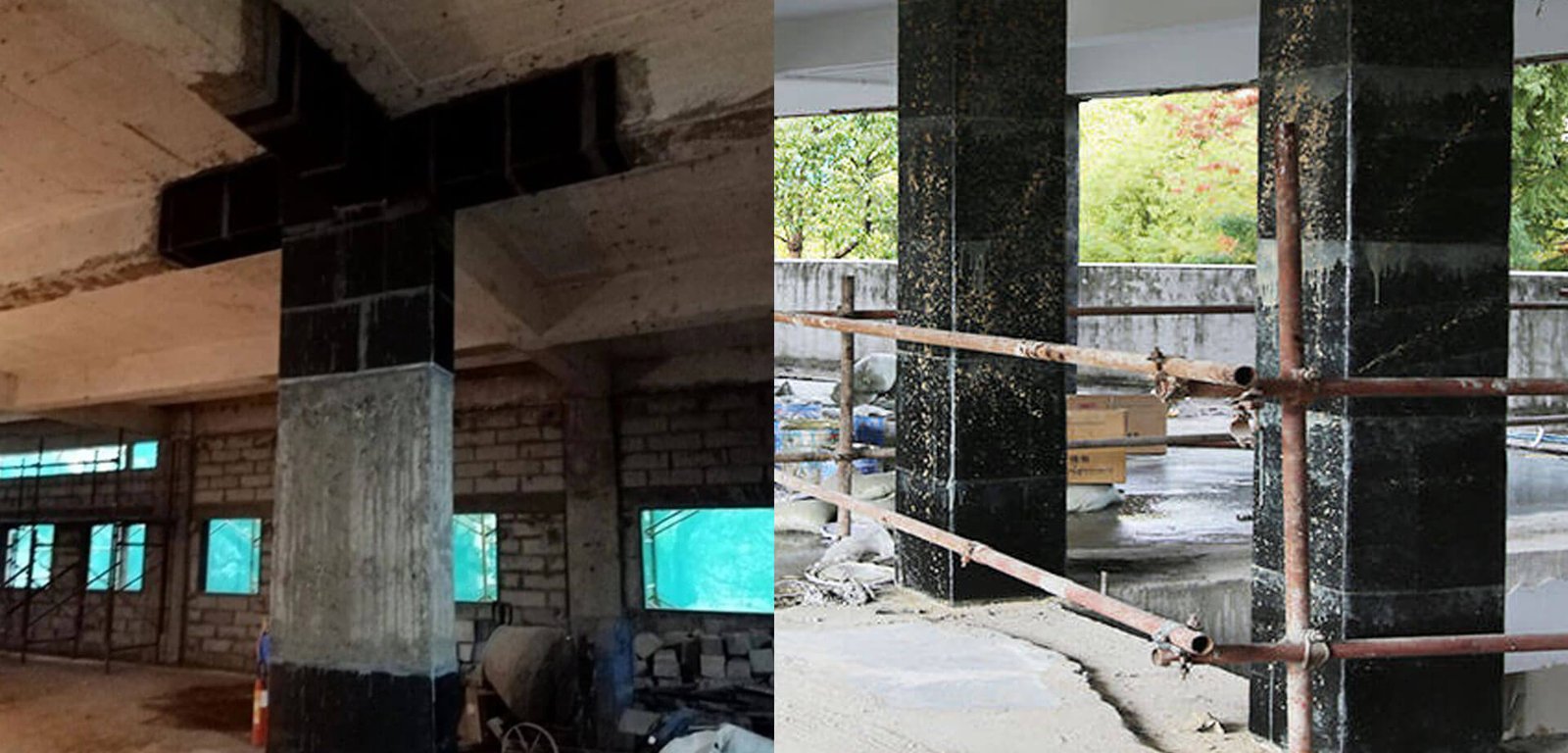Best Carbon Fibre Wrapping Services in India
High-Quality Carbon Fibre Wrapping Services for Structural Repair and Strengthening.
Strengthen and Repair Structures with Carbon Fiber Wrapping

Carbon fibre wrapping improves the strength of beams, columns, slabs, and other structures by increasing their load-carrying capacity. It also protects them from environmental damage, corrosion, and earthquake effects. Gubbi Civil Engineers provides customized Carbon Fibre Wrapping Services in India, ensuring the best results for every project.
What is Carbon Fibre Wrapping and How Does It Strengthen Structures?
Carbon Fibre Wrapping is a method that uses strong, lightweight carbon fibre sheets bonded to structures with epoxy resin. These fibres are thin, flexible, and extremely strong. When combined with resin, they create a durable material that can be shaped as needed.
This technique is used to strengthen concrete structures like columns, beams, slabs, bridges, docks, and foundations. The carbon fibre sheets are wrapped around the structure, increasing its strength, load capacity, and resistance to environmental and mechanical stress.

Advantages of Carbon Fibre Wrapping
- Strength and Load Capacity: Carbon fibre wrapping adds extra strength to concrete and reinforced concrete structures, helping them carry more weight without becoming weak or damaged.
- Resistance to Corrosion: Carbon fiber is not situation to corrosion as the other substances, and therefore it is well-suitable for wet environments, chemical publicity, or saltwater.
- Lightweight Fix: Carbon fiber is light, so it ensures that extra reinforcement will no longer grow the general weight of the structure and that no strain might be caused at the foundations and different individuals.
- The Strength: Carbon fiber wrapping has a long lifetime and safeguards structures from environmental factors, which include excessive temperatures, UV rays, and pollution.
- Protection Against Seismic Events: This approach can restore or save you seismic damage, which is very powerful for regions which might be vulnerable to earthquakes.
- Fixing Damaged Structures: This cloth can be used for broken or deteriorating RCC structures in which their original strength is recovered at the side of a purposeful hobby.
Carbon wrapping for industrial & commercial structures in India
- Carbon fiber's exceptional tensile strength significantly increases a structure's ability to withstand heavier loads when wrapped around columns or other structural elements. This is crucial for industrial buildings supporting heavy machinery or warehouses storing large amounts of goods.
- Carbon fibers are directly wrapped to the existing structure, minimizing interference and allowing for continued undisturbed building use during the process. This is particularly important for businesses that cannot afford downtime. This is crucial for industrial buildings supporting heavy machinery or warehouses storing large amounts of goods.
- Performance and aesthetics have been improved due to a thin layer of carbon fiber wrapped around the structure, which is barely visible.
- Carbon fiber exhibits high resistance to corrosion, unlike steel reinforcements can deteriorate over time.
The above advantages make it ideal for industrial environments exposed to harsh chemicals or moisture.

Gubbi Civil Engineers
Your Expert Partner for Carbon Wrapping Solutions
Gubbi Civil Engineers is a trusted name in the construction industry, offering cutting-edge solutions for structural strengthening. Here’s why you should choose us for carbon wrapping for columns, beams, and slabs:
Expertise in Advanced Techniques
The use of carbon fibre-reinforced polymer (CFRP) technology is the area of expertise for our team of skilled experts. We guarantee accurate implementation of carbon wrapping for beams, columns, or slabs to improve and restore structural integrity.
Customized Solutions
Every building has its own set of difficulties. To deliver customized carbon wrapping solutions that guarantee optimum efficiency and longevity, we evaluate the unique requirements of each structure.
Proven Quality Materials
Superior carbon fiber materials with outstanding strength-to-weight ratios are what we employ. These materials are perfect for keeping a smooth finish while reinforcing carbon wrapping for slabs, columns, and beams.
Cost-Effective Strengthening
An affordable substitute for conventional techniques of structural strengthening is carbon wrapping. You get a durable, effective solution from Gubbi Civil Engineers that also saves time and money.
Compliance with Industry Standards
Our carbon wrapping services meet worldwide quality requirements, guaranteeing your projects' sustainability, dependability, and safety.
Wide Range of Applications
Our carbon wrapping solutions for columns, beams, and slabs are adaptable and reliable, whether you're dealing with seismic retrofitting, load increase, or structural damage.
Gubbi Civil Engineers, Strengthening Structures, Ensuring Safety
Frequently Asked Questions
What is carbon fibre wrapping and how does it work?
Which structures can benefit from carbon fibre wrapping?
What are the advantages of carbon fibre wrapping?
Is carbon fibre wrapping suitable for industrial environments?
How long does carbon fibre wrapping last?
Will the installation of carbon fibre wrapping disrupt building operations?
Enhance the durability and strength of your building with our expert Carbon Wrapping Solutions for columns, beams, and slabs. We use advanced techniques, high-quality materials, and cost-effective solutions to ensure long-lasting structural reinforcement. Contact Us
📲 Call Now +91 9137067341
